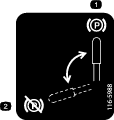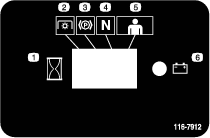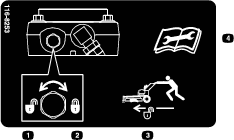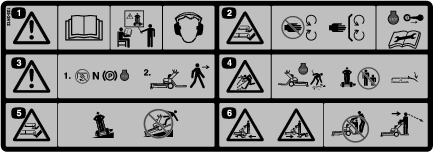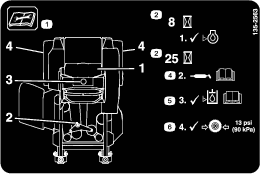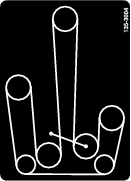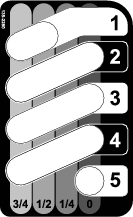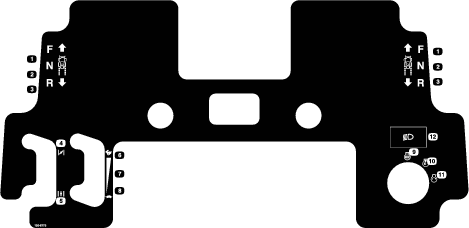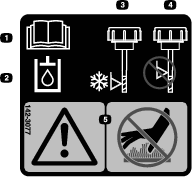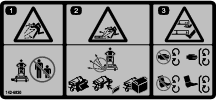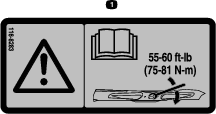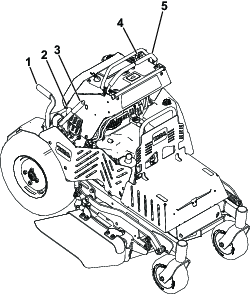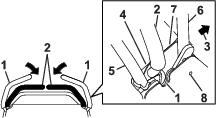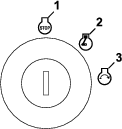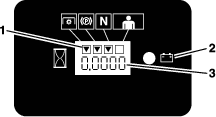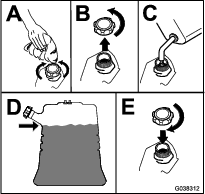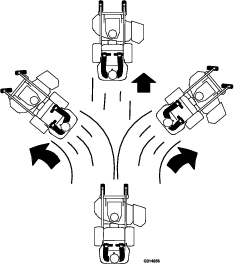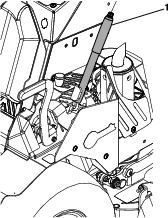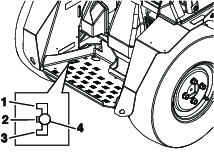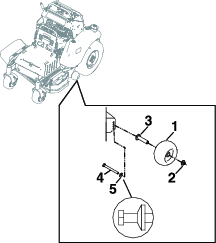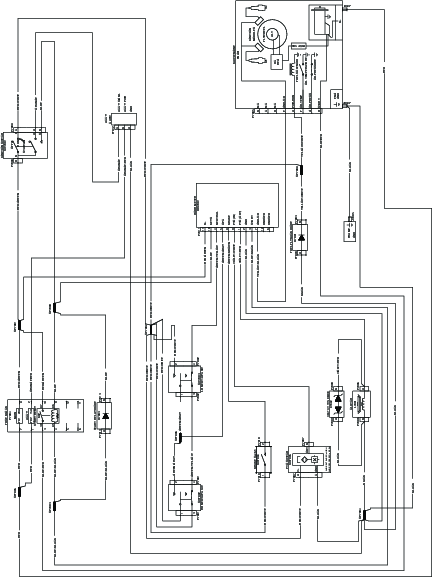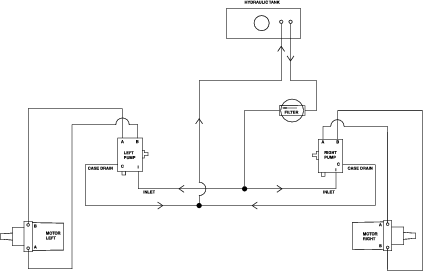Maintenance
Note: Determine the left and right sides of the machine from the normal operating position.
Caution
If you leave the ignition key in the switch, someone could accidently start the engine and serious injure you or other bystanders.
Remove the ignition key from the switch before you perform any maintenance.
Maintenance Safety
-
Before adjusting, cleaning, servicing, or leaving the machine, do the following:
-
Park the machine on a level surface.
-
Disengage the drives.
-
Engage the parking brake.
-
Shut off the engine and remove the ignition key.
-
Wait for all moving parts to stop.
-
Allow machine components to cool before performing maintenance.
-
-
Do not allow untrained personnel to service the machine.
-
Keep your hands and feet away from moving parts. If possible, do not make adjustments with the engine running.
-
Carefully release pressure from components with stored energy.
-
Check the parking brake operation frequently. Adjust and service the brake as needed.
-
Never tamper with safety devices. Check their proper operation regularly.
-
Clean grass and debris from the cutting unit, drives, muffler, and engine to help prevent fires. Clean up oil or fuel spills.
-
Check the grass catcher components frequently and replace them when they are worn or damaged.
-
Do not rely on a hydraulic system to support the machine; support the machine with jack stands whenever you raise the machine.
-
Keep all parts in good working condition and all hydraulic fittings tight. Replace all worn, damaged, or missing parts and decals. Keep all fasteners tight to ensure that the machine is in safe working condition.
-
To ensure optimum performance and continued safety certification of the machine, use only genuine Toro replacement parts and accessories. Replacement parts and accessories made by other manufacturers could be dangerous, and such use could void the product warranty.
Recommended Maintenance Schedule(s)
| Maintenance Service Interval | Maintenance Procedure |
|---|---|
| After the first 5 hours |
|
| After the first 100 hours |
|
| After the first 250 hours |
|
| Before each use or daily |
|
| Every 25 hours |
|
| Every 50 hours |
|
| Every 80 hours |
|
| Every 100 hours |
|
| Every 160 hours |
|
| Every 200 hours |
|
| Every 500 hours |
|
| Yearly |
|
Important: Refer to your engine owner’s manual for additional maintenance procedures.
Pre-Maintenance Procedures
Lift the Thigh Pad for Rear Access
The pad can be locked open to allow access to the hydro oil, pumps, ground drive belt, rotating screen, oil dipstick, and the fuel shut-off valves.
-
Lower the platform.
-
Lift the thigh pad all the way up. The pad will lock in an upwards position.
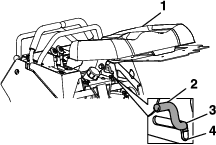
-
Perform any maintenance or adjustment on the machine.
-
Lift up on the wireform on the right side under the pad and lower the pad.
Removing the Rear Guard
-
Raise and lock the thigh pad.
-
Grab the top of the rear guard and pull rearward.
-
The top of the rear guard will pop loose from the brake shaft. Lift the guard from the slots in the frame and remove.
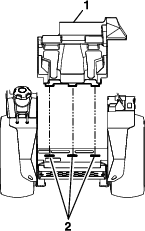
Installing the Rear Guard
To reinstall the rear guard, insert the three tabs into the slots in the bottom of the frame (Figure 18). Push the guard forward and snap over the brake shaft.
Lubrication
Lubricating the Grease Fittings
| Maintenance Service Interval | Maintenance Procedure |
|---|---|
| Yearly |
|
Note: See the chart for the service intervals.
-
Park the machine on a level surface, disengage the PTO, and engage the parking brake.
-
Shut off the engine, remove the key, and wait for all moving parts to stop before leaving the operating position.
-
Lubricate fittings with NLGI grade #2 multi-purpose gun grease.
Refer to the following chart for fitting locations and lubrication schedule.
Lubrication Chart
Fitting Locations Initial Pumps Number of Places Service Interval 1. Deck Belt Idler Pivot 1 1 Yearly 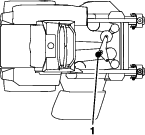
Engine Maintenance
Important: Refer to the engine owner’s manual for additional maintenance procedures.
Warning
The engine can become very hot, especially the muffler and exhaust components. Touching a hot engine can cause severe burns.
Allow the engine to cool completely before service or making repairs around the engine area.
Engine Safety
-
Shut off the engine before checking the oil or adding oil to the crankcase.
-
Keep your hands, feet, face, clothing, and other body parts away from the muffler and other hot surfaces.
-
Do not change the engine governor setting or overspeed the engine.
Servicing the Air Cleaner
| Maintenance Service Interval | Maintenance Procedure |
|---|---|
| Every 25 hours |
|
| Every 100 hours |
|
| Every 200 hours |
|
-
Park the machine on a level surface, disengage the PTO, and engage the parking brake.
-
Shut off the engine, remove the key, and wait for all moving parts to stop before leaving the operating position.
-
See the engine owner's manual for maintenance instructions.
Changing the Engine Oil
| Maintenance Service Interval | Maintenance Procedure |
|---|---|
| After the first 5 hours |
|
| Every 100 hours |
|
-
Park the machine on a level surface, disengage the PTO, and engage the parking brake.
-
Shut off the engine, remove the key, and wait for all moving parts to stop before leaving the operating position.
-
Drain oil while engine is warm from operation.
-
Lift and lock the thigh pad.
-
Remove and retain the rear guard.
-
Remove and retain the knob, washer, and air deflector located under the machine.

-
The oil drain valve is located on the left side of the engine.
Place the pan under the machine to catch the oil. Loosen the oil drain valve and allow the oil to drain. Tighten the oil drain valve.
-
Replace the oil filter per the Engine Owner's Manual. Clean around the oil filter and carefully remove the filter by unscrewing it. Make sure no oil drains onto the belt drive or clutch through the holes in the engine deck. Before the new filter is installed, apply a thin coating of oil on the surface of the rubber seal. Turn filter clockwise until rubber seal contacts the filter adapter, then tighten filter an additional 2/3 to 3/4 turn.
-
Clean around oil fill cap and remove cap. Fill to specified capacity and replace cap.
-
Use oil recommended in the Checking the Engine-Oil Level section. Do not overfill. Start the engine and check for leaks. Stop engine and recheck oil level.
-
Wipe up any spilled oil from engine deck mounting surfaces.
-
Reinstall the air deflector and rear guard.
-
Lower the thigh pad.
Checking the Engine-Oil Level
| Maintenance Service Interval | Maintenance Procedure |
|---|---|
| Before each use or daily |
|
-
Park the machine on a level surface, disengage the PTO, and engage the parking brake.
-
Shut off the engine, remove the key, and wait for all moving parts to stop before leaving the operating position.
-
Complete the check with the engine cold.
-
Clean the area around dipstick. Remove the dipstick and wipe oil off. Reinsert the dipstick according to the engine manufacturer's recommendations. Remove the dipstick and read the oil level.
-
If the oil level is low, wipe off the area around the oil fill cap, remove the cap and fill to the FULL mark on the dipstick. Refer to the Engine Owner's Manual for an appropriate API rating and viscosity. Do not overfill.
Important: Do not operate the engine with the oil level below the LOW (or ADD) mark on the dipstick, or over the FULL mark.
Checking the Spark Plugs
| Maintenance Service Interval | Maintenance Procedure |
|---|---|
| Every 160 hours |
|
Remove spark plugs, check condition and reset gaps, or replace with new plugs. See Engine Owner's Manual.
Checking the Spark Arrester
| Maintenance Service Interval | Maintenance Procedure |
|---|---|
| Every 50 hours |
|
Warning
Hot exhaust system components may ignite gasoline vapors even after the engine is stopped. Hot particles exhausted during engine operation may ignite flammable materials. Fire may result in personal injury or property damage.
Do not refuel or run engine unless spark arrester is installed.
-
Park the machine on a level surface, disengage the PTO, and engage the parking brake.
-
Shut off the engine, remove the key, and wait for all moving parts to stop before leaving the operating position.
-
Wait for muffler to cool.
-
If any breaks in the screen or welds are observed, replace arrester.
-
If plugging of the screen is observed, remove the arrester and shake loose particles out of the arrester and clean screen with a wire brush (soak in solvent if necessary). Reinstall the arrester on exhaust outlet.
Fuel System Maintenance
Changing the Fuel Filter
A fuel filter is installed in the fuel line between the fuel tank and the engine. Replace when necessary.
Electrical System Maintenance
Electrical System Safety
-
Disconnect the battery or remove the spark-plug wire before making any repairs. Disconnect the negative terminal first and the positive terminal last. Connect the positive terminal first and negative last.
-
Charge the battery in an open, well-ventilated area, away from sparks and flames. Unplug the charger before connecting or disconnecting the battery. Wear protective clothing and use insulated tools.
Checking the Battery Charge
Allowing batteries to stand for an extended period of time without recharging them will result in reduced performance and service life. To preserve optimum battery performance and life, recharge batteries in storage when the open circuit voltage drops to 12.4 volts.
Note: To prevent damage due to freezing, battery should be fully charged before putting away for winter storage.
Charge batteries in an open well ventilated area, away from spark and flames. Unplug charger before connecting or disconnecting from battery. Wear protective clothing and use insulated tools.
Danger
Charging or jump starting the battery may produce explosive gases. Battery gases can explode causing serious injury.
-
Keep sparks, flames, or cigarettes away from battery.
-
Ventilate when charging or using battery in an enclosed space.
-
Make sure venting path of battery is always open once battery is filled with acid.
-
Always shield eyes and face from battery.
Danger
Battery electrolyte contains sulfuric acid, which is poisonous and can cause severe burns. Swallowing electrolyte can be fatal or if it touches skin can cause severe burns.
-
Wear safety glasses to shield eyes, and rubber gloves to protect skin and clothing when handling electrolyte.
-
Do not swallow electrolyte.
-
In the event of an accident, flush with water and call a doctor immediately.
Caution
If the ignition is in the ON position there is potential for sparks and engagement of components. Sparks could cause an explosion or moving parts could accidentally engage causing personal injury.
Be sure ignition switch is in the OFF position before charging the battery.
Check the voltage of the battery with a digital voltmeter or with the message display When the ignition is set to the accessory mode, the module will display the battery voltage. If the voltage is less than 12.4 volts, the battery may need to be charged.
Important: Make sure the negative battery cable is disconnected and the battery charger used for charging the battery should have an output of 16 volts and 7 amps or less to avoid damaging the battery (see chart for recommended charger settings).
| Voltage Reading | Percent Charge | Maximum Charger Settings | Charging Interval |
|---|---|---|---|
| 12.6 or greater | 100% | 16 volts/7 amps | No Charging Required |
| 12.4 – 12.6 | 75–100% | 16 volts/7 amps | 30 Minutes |
| 12.2 – 12.4 | 50–75% | 16 volts/7 amps | 1 Hour |
| 12.0–12.2 | 25–50% | 14.4 volts/4 amps | 2 Hours |
| 11.7–12.0 | 0–25% | 14.4 volts/4 amps | 3 Hours |
| 11.7 or less | 0% | 14.4 volts/2 amps | 6 Hours or More |
Recommended Jump Starting Procedure
-
Check the weak battery for terminal corrosion (white, green, or blue “snow”), it must be cleaned off prior to jump starting. Clean and tighten the connections as necessary.
Caution
Corrosion or loose connections can cause unwanted electrical voltage spikes at anytime during the jump starting procedure.
Do not attempt to jump start with loose or corroded battery terminals or damage to the engine may occur.
Danger
Jump starting a weak battery that is cracked, frozen, has low electrolyte level, or an open/shorted battery cell, can cause an explosion resulting in serious personal injury.
Do not jump start a weak battery if these conditions exist.
-
Make sure the booster is a good and fully charged lead acid battery at 12.6 volts or greater. Use properly sized jumper cables (4 to 6 AWG) with short lengths to reduce voltage drop between systems. Make sure the cables are color coded or labeled for the correct polarity.
Caution
Connecting the jumper cables incorrectly (wrong polarity) can immediately damage the electrical system.
Be certain of battery terminal polarity and jumper cable polarity when hooking up batteries.
Note: The following instructions are adapted from the SAE J1494 Rev. Dec. 2001 – Battery Booster Cables – Surface Vehicle Recommended Practice (SAE – Society of Automotive Engineers).
Warning
Batteries contain acid and produce explosive gases.
-
Shield the eyes and face from the batteries at all times.
-
Do not lean over the batteries.
Note: Be sure the vent caps are tight and level. Place a damp cloth, if available, over any vent caps on both batteries. Be sure the vehicles do not touch and that both electrical systems are off and at the same rated system voltage. These instructions are for negative ground systems only.
-
-
Connect the positive (+) cable to the positive (+) terminal of the discharged battery that is wired to the starter or solenoid.
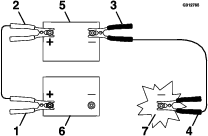
-
Connect the other end of the positive cable to the positive terminal of the booster battery.
-
Connect the black negative (–) cable to the other terminal (negative) of the booster battery.
-
Make the final connection on the engine block of the stalled vehicle (no to the negative post) away from the battery. Stand back.
-
Start the vehicle and remove the cables in the reverse order of connection (the engine block (black) connection is the first to disconnect).
Drive System Maintenance
Checking the Tire Pressures
| Maintenance Service Interval | Maintenance Procedure |
|---|---|
| Every 50 hours |
|
-
Park the machine on a level surface, disengage the PTO, and engage the parking brake.
-
Shut off the engine, remove the key, and wait for all moving parts to stop before leaving the operating position.
-
Check the tire pressure in drive tires.
-
Inflate the drive tires to 83 to 97 kPa (12 to 14 psi).
-
Semi-pneumatic caster tires do not need to be inflated.
Wheel Hub Nut Torque Specification
| Maintenance Service Interval | Maintenance Procedure |
|---|---|
| After the first 100 hours |
|
| Every 500 hours |
|
Check and torque the nut on the wheel motor tapered shaft to 156 to 183 N∙m (115 to 135 ft-lb).
Note: Do not use anti-seize compound on the wheel hub.
Brake Maintenance
Adjusting the Parking Brake
If the parking brake does not hold securely, an adjustment is required.
-
Park the machine on a level surface, disengage the PTO, and engage the parking brake.
-
Shut off the engine, remove the key, and wait for all moving parts to stop before leaving the operating position.
-
When the park brake is released, the brake bars should lift off the tires and the hand lever should travel forward. When the brake is disengaged, the gap between the brake snubber teeth and drive tire should measure 16 to 19 mm (5/8 to 3/4 inch) (Figure 21).
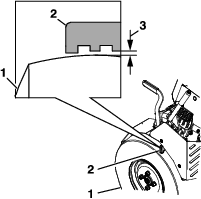
-
If the parking brake does not hold securely, an adjustment is required.
-
Remove and retain the rear guard.
-
To adjust the brake, loosen the jam nut at the lower end of the ball joint. and retain the hairpin and washer on the brake linkage rod. Turn the 2 jam nuts on the brake linkage rod until the distance between the 2 ball joints is reached as shown in Figure 22. Turn the brake linkage rod clockwise to decrease the distance and counterclockwise to increase the distance.
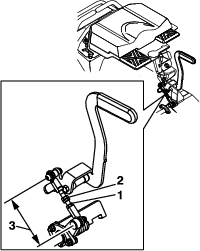
-
Tighten the jam nut at the lower end of the ball joint.
-
Install the rear guard.
Belt Maintenance
Checking the Belts
| Maintenance Service Interval | Maintenance Procedure |
|---|---|
| Every 50 hours |
|
-
Park the machine on a level surface, disengage the PTO, and engage the parking brake.
-
Shut off the engine, remove the key, and wait for all moving parts to stop before leaving the operating position.
-
Look on the top side of the cutting deck to check the mower blade drive belt condition.
-
Look under the engine deck to check the pump drive belt condition.
-
Check all idler arms to ensure they pivot freely.
Pump Drive Belt Tension
Self-tensioning - No adjustment necessary.
Mower Deck Drive Belt Tension
Self-tensioning - No adjustment necessary.
Controls System Maintenance
Adjusting the Motion-Control Handle Position
If the motion control levers do not align horizontally, adjust one or both levers.
Note: Adjust the horizontal alignment before the front to back alignment.
-
Park the machine on a level surface, disengage the PTO, and engage the parking brake.
-
Shut off the engine, remove the key, and wait for all moving parts to stop before leaving the operating position.
-
Push the right motion control lever down out of the PTO disengage position.
-
Check if the right motion control lever aligns horizontally with the left motion control lever.
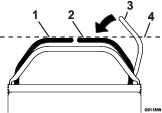
-
To adjust the right motion control lever horizontally, the cam needs to be adjusted.
-
Release the cushion from the rear of the machine.
-
Loosen the nut holding the cam.

-
Adjust the cam until it aligns with the left motion control lever and tighten the nut for the cam.
Note: Moving the flat portion of the cam clockwise lowers the handle, while moving it counterclockwise raises the handle
Important: Make sure the flat portion of the cam does not go above a vertical position (right or left), or damage may occur to the switch.
-
Tighten the switch screws.
Adjusting Motion-Control Tracking
Located in the front inside the tower. Rotating the pump linkage with a wrench (9/16 inch) allows fine tuning adjustments so that the machine does not move in neutral. Any adjustments should be made for neutral positioning only.
-
Raise the rear of machine up and support with jack stands (or equivalent support) just high enough to allow drive wheels to turn freely.
-
Start the engine. The brake must be engaged and motion control levers out to start engine. Run the engine at full throttle and release the brake.
-
Run the unit at least 5 minutes with the drive levers at full forward speed to bring hydraulic oil up to operating temperature.
Note: The motion control lever needs to be in neutral while making any necessary adjustments.
-
Bring the motion control levers into the neutral position. Access the links from the front of the tower. Adjust the pump control rod lengths by loosening the lower and middle nuts on each and rotating the turn buckle until the wheels slightly creep in reverse. The pumps have a return to neutral arms and will return to neutral when the control levers are released. If the levers do not fold out, adjust the links until the lever folds out in the middle of the neutral lock notch. Move the levers to the full forward and reverse. If the levers fold out, tighten the lower and middle jam nuts on the links, followed by the upper jam nut last.
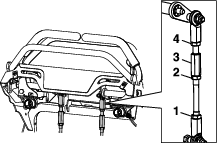
-
Shut off the machine.
-
Remove the jack stands.
-
Check that the machine does not creep in neutral with the park brakes disengaged.
Hydraulic System Maintenance
Hydraulic System Safety
-
Seek immediate medical attention if fluid is injected into skin. Injected fluid must be surgically removed within a few hours by a doctor.
-
Ensure that all hydraulic-fluid hoses and lines are in good condition and all hydraulic connections and fittings are tight before applying pressure to the hydraulic system.
-
Keep your body and hands away from pinhole leaks or nozzles that eject high-pressure hydraulic fluid.
-
Use cardboard or paper to find hydraulic leaks.
-
Safely relieve all pressure in the hydraulic system before performing any work on the hydraulic system.
Hydraulic System Specifications
Hydraulic Fluid Type: Toro® HYPR-OIL™ 500 hydraulic fluid
Hydraulic System Fluid Capacity: 2.2 L (74.39 fl oz)
Important: Use the fluid specified. Other fluids could damage the system.
Checking the Hydraulic Oil Level
| Maintenance Service Interval | Maintenance Procedure |
|---|---|
| Every 50 hours |
|
-
Park the machine on a level surface, disengage the PTO, and engage the parking brake.
-
Shut off the engine, remove the key, and wait for all moving parts to stop before leaving the operating position.
-
Lift and lock the thigh pad.
-
Clean area around hydraulic reservoir cap and remove cap. Oil level should be to in the cross hatch on the dipstick when cold. If not, add oil. Replace hydraulic reservoir cap and tighten until snug. Do not overtighten.
-
Wipe the dipstick clean and re-insert the cap into the hydraulic tank. Lightly tighten the cap.
-
Remove the cap again and check the level of the oil on the dipstick. See Figure 26 for oil levels.

Note: The oil level on the dipstick will be incorrect if the oil is checked when the unit is hot.
-
If the dipstick oil level does not register on the dipstick, add hydraulic oil. Do not overfill.
-
Install hydraulic reservoir cap and tighten until snug. Do not overtighten.
-
Lower the thigh pad.
Replacing the Hydraulic Fluid and Filters
| Maintenance Service Interval | Maintenance Procedure |
|---|---|
| After the first 250 hours |
|
| Every 500 hours |
|
Change the hydraulic fluid more frequently in severe conditions or in a hot operating climate. Contact your Authorized Service Dealer for a hydraulic kit to replace the hydraulic filters.
Warning
Hot hydraulic fluid can cause severe burns.
Allow the hydraulic fluid to cool before performing any maintenance on the hydraulic system.
-
Park the machine on a level surface, disengage the PTO, and engage the parking brake.
-
Shut off the engine, remove the key, and wait for all moving parts to stop before leaving the operating position.
-
Remove the right side guard.
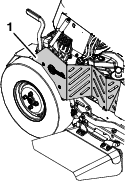
-
Place a catch pan under the hydraulic filter.
-
Carefully clean the area around filter. It is important that no dirt or contamination enters hydraulic system.
-
Unscrew the filter to remove and allow the oil to drain from the reservoir.
Important: Before reinstalling new filter, fill it with Toro Hypr-Oil 500 and apply a thin coat of oil on the surface of the rubber seal.
Turn the filter clockwise until the rubber seal contacts the filter adapter, then tighten the filter an additional 2/3 to 3/4 turn.
-
Fill the reservoir as stated in Checking the Hydraulic Oil Level
Toro Hypr-Oil 500 is recommended. Refer to the chart for an acceptable alternative:
Hydro Oil Service Interval Toro Hypr-Oil 500 (Preferred) After first 250 hours*Every 500 hours/Yearly thereafter Mobil 1 15W50 After first 250 hours *Every 250 hours/Yearly thereafter *May need more often under severe conditions.
-
Loosen the filter 1/2 turn and allow a small amount of oil to leak from the oil filter (this allows air to be purged from the oil filter and supply hose from the hydraulic reservoir). Turn the filter clockwise until the rubber seal contacts the filter adapter. Then tighten the filter an additional 2/3 to 3/4 turn.
-
Raise the rear of machine up and support with jack stands (or equivalent support) just high enough to allow drive wheels to turn freely.
Caution
Raising the mower for service or maintenance relying solely on mechanical or hydraulic jacks could be dangerous. The mechanical or hydraulic jacks may not be enough support or may malfunction allowing the unit to fall, which could cause injury.
Do not rely solely on mechanical or hydraulic jacks for support. Use adequate jack stands or equivalent support.
-
Start the engine and move the throttle control ahead to the full throttle position. Move the motion control levers inward (together) and move both levers forward with equal pressure, and run for one minute. Shut down the machine, allow the hydraulic components to cool and recheck the oil level.
If either drive wheel does not rotate, one or both of the charge pumps (located on the top of the main pump as shown in Figure 28) may have lost their “prime”. Refer to Hydraulic System Air Purge
-
Install the right side guard.
-
Remove the jack stands.
Note: Do not change the hydraulic system oil (except for what can be drained when changing filter), unless it is felt the oil has been contaminated or been extremely hot.Changing oil unnecessarily could damage hydraulic system by introducing contaminates into the system.
Hydraulic System Air Purge
Air must be purged from the hydraulic system when any hydraulic components, including oil filter, are removed or any of the hydraulic lines are disconnected.
The critical area for purging air from the hydraulic system is between the oil reservoir and each charge pump located on the top of each variable displacement pump (Figure 28). Air in other parts of the hydraulic system will be purged through normal operation once the charge pump is “primed”.
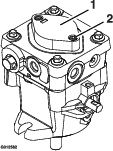
-
Stop the engine and wait for all moving parts to stop. Raise the rear of the machine up onto jack stands high enough to raise the drive wheels off the ground.
-
Check oil level. Refer to Checking the Hydraulic Oil Level.
-
Start the engine and move throttle control ahead to full throttle position. Move the motion control levers inward (together) and move both levers forward with equal pressure.
If either drive wheel does not rotate, it is possible to assist the purging of the charge pump by carefully rotating the tire in the forward position.
Note: It is necessary to lightly touch the charge pump cap with your hand to check the pump temperature. If the cap is too hot to touch, turn off the engine. The pumps may be damaged if the pump becomes too hot.
If either drive wheel still does not rotate continue with step .
-
Thoroughly clean the area around each of the charge pump housings.
-
To “prime” charge pump, loosen two hex socket head capscrews (shown in Figure ) 1-1/2 turns only. Make sure the engine is not running. Lift the charge pump housing upward and wait for a steady flow of oil to flow out from under the housing. Retighten the capscrews. Do this for both pumps.
Note: The hydraulic reservoir can be pressurized up to 5 psi to speed this process.
-
If either drive wheel still does not rotate, stop and repeat steps and above for the respective pump. If wheels rotate slowly, the system may prime after additional running. Check oil level as stated in Checking the Hydraulic Oil Level section.
-
Allow unit to run several minutes after the charge pumps are “primed” with drive system in the full speed position. Check oil level as stated in Checking the Hydraulic Oil Level section.
Mower Deck Maintenance
Blade Safety
A worn or damaged blade can break, and a piece of the blade could be thrown toward you or bystanders, resulting in serious personal injury or death.
-
Inspect the blades periodically for wear or damage.
-
Use care when checking the blades. Wrap the blades or wear gloves, and use caution when servicing the blades. Only replace or sharpen the blades; never straighten or weld them.
-
Always inspect the machine to ensure that the blades and blade bolts are not worn or damaged. Replace worn or damaged blades and bolts in sets to preserve balance.
-
On multi-bladed machines, take care as rotating 1 blade can cause other blades to rotate.
Checking the Mower Blades
-
Park the machine on a level surface, disengage the PTO, and engage the parking brake.
-
Shut off the engine, remove the key, and disconnect the spark-plug wires from the spark plugs.
-
Lift the deck and secure it in raised position as stated in the Clean Grass Build-Up Under Deck section.
-
Inspect the blades and sharpen or replace as required.
-
Reinstall the blades (if they were removed) in the following order:
-
Install the bushing through blade with the bushing flange on bottom (grass) side of blade.
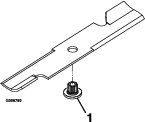
-
Install the bushing/blade assembly into the spindle.
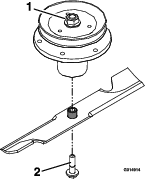
-
Apply lubricant to the threads of the blade bolt as needed to prevent seizing. Copper-based anti-seize is preferable. Grease is an acceptable substitute. Install the blade bolt finger tight. Place wrench on the top spindle nut then torque the blade bolts to 68 to 81 N∙m (50 to 60 ft-lb).
Warning
Incorrect installation of the blade or components used to retain the blade can be dangerous. Failure to use all original components and assembled as shown could allow a blade or blade component to be thrown out from under the deck resulting in serious personal injury or death.
Always install the original Toro blades, blade bushings, and blade bolts as shown.
-
Leveling the Mower Deck
Note: Small adjustments can be accomplished by increasing the tire pressure in the tire on the low side.
-
Park the machine on a level surface, disengage the PTO, and engage the parking brake.
-
Shut off the engine, remove the key, and disconnect the spark-plug wires from the spark plugs.
-
Check the tire pressure in drive tires and pneumatic front caster tires (if equipped). Proper inflation pressure for tires is 90 kPa (13 psi). Adjust if necessary.
-
Pull the deck lift handle all the way rearward to latch the cutting deck into the raised transport position.
-
Insert the height adjustment pin into the 7.6 cm (3 inches) cutting height location.
-
Release the transport lock and allow the deck to lower to the cutting height.
-
Raise the discharge deflector.
-
Carefully rotate the blades front to rear. Measure from the level surface to the front tip of the center blade. The measurement should read 7.6 cm (3 inches).
Note: In most conditions, the back tips on the side blades should be adjusted 3.2 to 6.4 mm (1/8 to 1/4 inch) higher than the front.
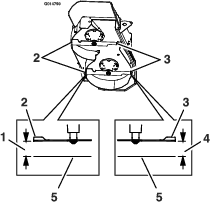
-
Raise the deck to transport position.
-
Slowly loosen the adjusting screw on the lift assist spring until the screw can be removed (Figure 32). Save the screw for reinstallation.
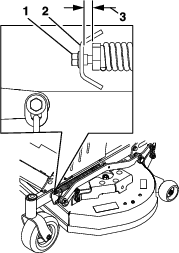
-
Set the height of the cut lever to the 7.6 cm (3 inches) position. Place a 6.7 cm (2-5/8 inches) tall block under the front deck skirt and a 7.0 to 7.3 cm (2-3/4 to 2-7/8 inches) block under the rear skirt.
-
Loosen the hardware at the bottom of all four lift chains so the deck is sitting securely on the blocks (Figure 33). Make sure the slack is removed from the lift chains and retighten the hardware.
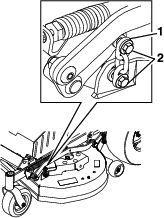
-
Raise the deck and remove the blocks. Lower the deck back to 7.6 cm (3 inches) and recheck the cutting height.
-
Raise the deck into the transport position and reinstall the deck lift assist spring. Tighten the adjuster screw until a 6.0 to 6.4 cm (2-3/8 to 2-1/2 inches) gap is present (Figure 33).
Note: If the front to rear blade tip height difference is good, but the height is off, additional adjustments can be made using the lift rod.
-
Loosen both of the jam nuts on the lift rod and rotate the rod to raise or lower the deck. Tighten the jam nuts when desired position is achieved (Figure 34).

Maintaining the Chassis
Checking for Loose Hardware
| Maintenance Service Interval | Maintenance Procedure |
|---|---|
| Before each use or daily |
|
-
Park the machine on a level surface, disengage the PTO, and engage the parking brake.
-
Shut off the engine, remove the key, and wait for all moving parts to stop before leaving the operating position.
-
Visually inspect the machine for any loose hardware or any other possible problem. Tighten the hardware or correct the problem before operating.
Cleaning
Cleaning and Storing Safety
-
Park machine on level ground, disengage drives, set parking brake, stop engine, remove key, and disconnect spark plug wire. Wait for all moving parts to stop before leaving the operator’s position. Allow the machine to cool before servicing, adjusting, fueling, cleaning, or storing.
-
Clean grass and debris from the cutting unit, muffler, drives, grass catcher, and engine compartment to prevent fires.
-
Allow the machine to cool before storing the machine in any enclosure. Do not store the machine or fuel container, or refuel, where there is an open flame, spark, or pilot light such as on a water heater or other appliance.
Clean Debris From Machine
| Maintenance Service Interval | Maintenance Procedure |
|---|---|
| Before each use or daily |
|
-
Stop engine, wait for all moving parts to stop, and remove key. Engage parking brake.
-
Clean off any oil, debris, or grass build-up on the machine and cutting deck, especially under deck belt shields, around the fuel tank, around engine and exhaust area.
Important: You can wash the machine with mild detergent and water. Do not pressure wash the machine. Avoid excessive use of water, especially near the control panel, around the engine, hydraulic pumps, and motors.
Clean Engine and Exhaust System Area
| Maintenance Service Interval | Maintenance Procedure |
|---|---|
| Before each use or daily |
|
Caution
Excessive debris around engine cooling air intake and exhaust system area can cause engine, exhaust area, and hydraulic system to overheat which can create a fire hazard.
Clean all debris from engine and exhaust system area.
-
Stop engine, wait for all moving parts to stop, and remove key. Engage parking brake.
-
Clean all debris from rotating engine air intake screen, around engine shrouding, and exhaust system area.
-
Wipe up any excessive grease or oil around the engine and exhaust system area.
-
Clean oil coolers (if equipped) of all debris, dirt, and oil.
Remove Engine Shroud Access Panels and Clean Cooling Fins
| Maintenance Service Interval | Maintenance Procedure |
|---|---|
| Every 80 hours |
|
-
Stop engine, wait for all moving parts to stop, and remove key. Engage parking brake.
-
Remove cooling shroud access panels from engine and clean cooling fins. Also clean dust, dirt, and oil from external surfaces of engine which can cause improper cooling.
-
Make sure cooling shroud access panels are properly reinstalled. Operating the engine without cooling shroud access panels will cause engine damage due to overheating.
Clean Grass Build-Up Under Deck
| Maintenance Service Interval | Maintenance Procedure |
|---|---|
| Before each use or daily |
|
-
Stop engine, wait for all moving parts to stop, and remove key. Engage parking brake.
-
Raise deck to the transport (maximum cutting height) position. Lift the front of unit and support machine using jack stands or equivalent support.
-
Clean out any grass build-up from underside of deck and in discharge deflector.
Waste Disposal
Motor Oil Disposal
Engine oil and hydraulic oil are both pollutants to the environment. Dispose of used oil at a certified recycling center or according to your state and local regulations.
Battery Disposal
Danger
Battery electrolyte contains sulfuric acid, which is poisonous and can cause severe burns. Swallowing electrolyte can be fatal or if it touches skin can cause severe burns.
-
Wear safety glasses to shield eyes, and rubber gloves to protect skin and clothing when handling electrolyte.
-
Do Not swallow electrolyte.
-
In the event of an accident, flush with water and call a doctor immediately.
Federal law states that batteries should not be placed in the garbage. Management and disposal practices must be within relevant federal, state, or local laws.
If a battery is being replaced or if the unit containing the battery is no longer operating and is being scrapped, take the battery to a local certified recycling center. If no local recycling is available return the battery to any certified battery reseller.
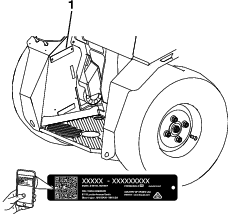

 , which means Caution, Warning,
or Danger—personal safety instruction. Failure to comply with
these instructions may result in personal injury or death.
, which means Caution, Warning,
or Danger—personal safety instruction. Failure to comply with
these instructions may result in personal injury or death.




